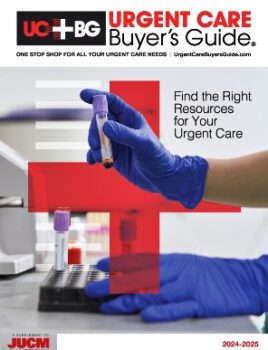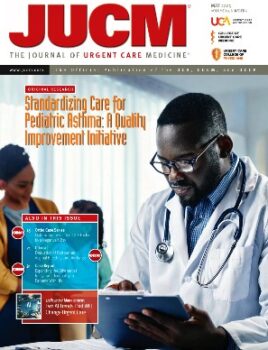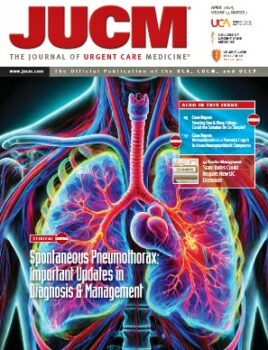![]()

Urgent message: Urgent care operators are spending an increasing amount of their marketing budget on seven digital tactics.
Fortunately for those working in healthcare, there will never be a shortage of patients. People will always come down with illnesses, and minor injuries won’t go away anytime soon. That being said, it can still be difficult to get people in the door of your specific urgent care center.
Although it often gets neglected, proper marketing is one of the most important pieces of running an urgent care—aside from providing high-quality clinical services. In today’s world, digital marketing is typically the best route to pursue. It allows your company to connect with potential customers across platforms they use every day and on devices they are familiar with.
Of course, not all digital marketing is built equally. The seven strategies outlined in this article are ones that should be adopted by every urgent care center. They are validated by research and years of industry experience and, if done correctly, will help drive customers to your business.
A ROBUST WEBSITE
Your website is most likely the way potential customers will learn about your urgent care center and its services. Although people may arrive at your website in a variety of ways, it serves as one central location for you to put your best foot forward.
Your website lets you tell customers who you are, what you do, and even lets you start offering convenient services before they walk through the door.
From a marketing standpoint, your website is key to getting your brand in front of potential customers. This is accomplished by ensuring that your site is optimized for search engines so it can boost your business in the rankings and increase your visibility. But, what does it mean to optimize your website for search engines like Google, Yahoo, and Bing?
While search engine optimization (SEO) can be an entire topic on its own, the basics are rather simple. You should ensure that your website contains rich keywords that reflect what customers are searching for. As an example, including terms for common conditions seen in your clinic can make your website appear when people are searching for symptoms of those conditions.
Meanwhile, your site should look great on mobile devices and contain information that can be picked up by voice searches.
With all this in mind, don’t forget that your website also needs to be attractive to people—not just search engines. It should be clean, modern, and professional. This gives potential customers a good first impression.
To accomplish this, ensure that your website loads quickly on all devices, is easy to navigate, and that all aspects of it are working. Nothing drives people away faster than a site that takes too long to load or one that is hard to navigate.
Finally, your website needs to be multifunctional. Visitors should be able to easily locate information regarding your services, locations, and hours. This helps reduce the number of phone calls employees must take and frees up their time to do more important tasks.
You can make your website more helpful by including tools like online registration, medical records retrieval, test result viewing, and electronic bill payments.
Create Interesting Content
When it comes to reaching people with your message, you need to ensure that potential customers are getting something out of it. No one is browsing the internet looking for a blog post from a neighborhood urgent care chain.
That being said, many people are willing to click on that blog post if they find it interesting or if they believe it will help them in some way. When you’re creating marketing content for your urgent care business, ensure that it is interesting and offers value for the consumer.
Posting keyword-rich blog content is one way to accomplish this. The SEO-focused keywords help get your content in front of people by catering to search engines, and engaging, beneficial topics get them to click. When determining the topics, be aware of things that are trending in recent searches or local news. This increases the likelihood that people will find your content and subsequently share it.
You’ll also want to keep your target audience in mind. Although anyone can benefit from urgent care services, certain trends do occur in the industry. For instance, many urgent care companies design their marketing content around the healthcare decision-maker of a family. In many cases, this is a woman between the ages of 24 and 55. Identifying your ideal target audience helps you create content that is more useful and interesting to potential consumers.
Once you identify the target audience and have created engaging, helpful content, it’s time to share it. This should be done through multiple outlets and with several types of media. Aim to distribute your marketing content in blog format on your website, as videos on YouTube, in photo form on Instagram, and as short text posts on Facebook. Using multiple outlets gets your content in front of as many people as possible.
Meanwhile, urgent care centers should work on developing relationships with local news outlets, including TV stations, radio stations, and newspapers. Be sure to share news and updates with these agencies regularly. Getting your executives and employees quoted in their stories is even better. Then, you can repost that content across your channels. This builds trust in the community and helps spread awareness about your company.
ONLINE REPUTATION MANAGEMENT
For any business, but especially urgent care centers, word of mouth goes a long way. Online reviews can be tremendous for your business. Companies that have more positive reviews typically find themselves positioned higher in search engine rankings than their competitors.
Urgent care companies should actively encourage patients to leave reviews on platforms like Google, Yelp, and Facebook. While Google is certainly the most important review platform, the others shouldn’t be overlooked. For instance, Yelp is mainly used for the restaurant industry but helps attract traffic when people are browsing using a search engine like Bing instead of Google.
Getting customers to leave reviews can be done in a few ways. Reminders should be posted in your urgent care center. Many companies then follow up by sending patients a text message or email survey 30–60 minutes after they are discharged. This is the ideal timeframe to garner the most feedback.
If the patient responds positively to the survey, your company can then encourage them to leave a rating and/or review on Google. This twofold approach helps boost the number of positive reviews your business receives.
Ultimately, seeing that one urgent care company has more positive reviews than a competitor can help get new patients in the door.
LOCAL TARGETING
Thanks to the ubiquity of smartphones, businesses can interact with customers like never before. From a marketing standpoint, a phone’s GPS hardware is one of its most important components.
Local targeting allows businesses to advertise to customers within a certain geographic location. Since urgent care companies mainly cater to those within a certain vicinity of each practice, this is an extremely valuable tool.
Using geofencing strategies on platforms like Google Display Network lets your company create advertising “zones.”
When people on mobile devices are in those areas, they’ll see locally branded ads for your urgent care center. Setting up these zones around high-traffic areas like schools, fitness centers, and grocery stores can help get your message out to a relevant audience.
Doing so also pushes your company to the top of the customer’s mind. Then, when the need for urgent care arises, they are more likely to remember your business and turn to you for care.
SOCIAL MEDIA
While setting up a website requires a significant investment, social media makes it easy for anyone to advertise online. It gives urgent care businesses a tremendous amount of flexibility.
If you need more visits on a certain day, you create a Facebook post and “boost” it within minutes to start advertising to customers. Compared to the months-long process of advertising with traditional methods like a billboard or newspaper ad, social media is much faster and efficient.
Likewise, social media advertising lets you target your audience in a variety of ways. You can tailor your posts to certain demographic groups, geographic locations, and even personal interests. This lets you get your message out to the right people instead of just sharing it with everyone that passes by.
Even when you aren’t purposefully advertising, posting regularly on social media is a great way to give your company a strong identity. People who “follow” or “friend” your urgent care center’s social media pages will receive regular updates. This keeps them informed about promotions, limited-time events or screenings, and announcements of things like opening a new location.
Better yet, as these people see and get familiar with your posts, they more are likely to comment and share them with friends. This spreads your company’s message even further.
GMAIL
We’ve covered the fact that social media is a great advertising tool for urgent care companies. However, it isn’t the only useful method. Around the world, email is used by billions of people on a daily basis and is a perfect way to connect with potential customers.
Estimates suggest that Gmail accounts for 43% of all free email accounts and 27% of all email openings.1 That’s thanks to the fact that Gmail has more than 1.8 billion users. This makes it a perfect platform to use for targeted advertising.
Companies can target users based on things like gender, age, household income, and even internet search activity. This allows you to get your message in front of people who are most likely to listen to it and gain something from what your urgent care business has to offer.
Since people spend about 2.5 hours per day checking their personal email accounts, this can be a unique way to connect with them.2 It differs from many types of digital marketing and that may be enough to catch their attention.
REMARKETING
The Rule of 7 is a term that’s thrown around frequently in the advertising world. It means that people generally need to see a company’s message seven times before they are willing to make a purchase.3 The strategies discussed so far help you get your brand in front of people.
However, showing potential customers an ad or leading them to your website one time won’t be enough. Remarketing is a crucial part of any digital marketing strategy.
This can take a few forms. For instance, when a person visits your urgent care website and then clicks away, they’ll see ads for your practice over the next few days. This will repeatedly put your company at the forefront of their mind.
For those dealing with a medical condition, it may take multiple visits to a website before they are ready to visit your clinic in-person. Strong remarketing encourages people to visit your business rather than a competitor’s.
PAY-PER-CLICK ADVERTISING
There are plenty of free ways to get your urgent care company’s message out to people. Your website, regular social media posts, and positive customer reviews are just a few. However, paid marketing solutions are also an important part of the process.
One of the most popular methods is known as pay-per-click advertising. This is typically done through platforms like Google Adwords. It allows you to target certain keywords and search results and then place an ad for your business at the top of the page. The ad links to your Google Business profile, your website, or even a Facebook page.
The majority of urgent care is geared towards people looking to address a certain problem. Pay-per-click advertising focuses on that segment of internet users. For instance, an urgent care clinic could target terms like STD testing, on-site x-ray, or COVID-19 testing. Users searching for those terms would then see an ad for your urgent care practice at the top of the results page.
Capturing people’s attention at the exact moment they are trying to address a need means there is a high likelihood of turning them into a customer.
IN CONCLUSION
It’s clear that a sound digital marketing strategy is essential for every urgent care business. Although there are always people in need of urgent care services, getting them to your clinic requires a dedicated approach.
Using a variety of digital marketing tactics is the best way to do this. A strong website and pay-per-click advertising campaign get your business to the top of the search results. Positive reviews and connections with local news outlets build trust in your brand. A strong social media presence helps spread word of mouth and gets you connected in the community. Finally, paid advertising with fine-tuned targeting gets your message to those who are most likely to come through the doors.
By combining these strategies, your urgent care business will be poised for success in today’s digital age.
References
- Petrov C. 50 Gmail statistics to show how bit it is in 2020. Techjury. Available at: https://techjury.net/blog/gmail-statistics/#gref. Accessed March 6, 2021.
- Silva-Payne G. How to track and reduce your time spent on email. emailmeter. Available at: https://www.emailmeter.com/blog/track-time-spent-on-email. Accessed March 6, 2021.
- Kruse K. Rule of 7: how social media crushes old school marketing. Kruse Control Inc. Available at: https://www.krusecontrolinc.com/rule-of-7-how-social-media-crushes-old-school-marketing/. Accessed March 6, 2021.
Related Articles
- Adapting Urgent Care Marketing Strategies To Include Mobile And Voice Technologies
- Use Digital Marketing And Social Media To Attract And Engage New Urgent Care Patients
- Competing For Patients In A Digitally Connected World
Core Content in Urgent Care Nursing and Medical Assisting
 Core Content in Urgent Care Nursing and Medical Assisting
Core Content in Urgent Care Nursing and Medical Assisting
The Core Content in Urgent Care Nursing and Medical Assisting…
 480-245-6400
480-245-6400









